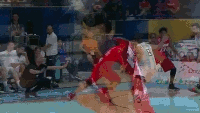So weve talked about the Raptors and hedging.
Weve talked about perhaps more switching/BLUEing on PnR.
Lets talk about the double team.
I was reading a Vantage article about this (I hadnt seen it posted), so lets cite all the Raps stuff first.
**Effective Double-Team Rate is defined in the Vantage glossary as the percentage of double-teams that lead directly to a Contest+ shot attempt, tie-up, deflection, offensive foul, denied pass, or turnover.

So as you can see they have the lowest effective double team rate %, yet still give up few points allowed when actually double teaming.
There are some gifs, but im just going to post the text.
In fact, there seems to be a positive relationship between Effective Double-Team Rate and Points Allowed per 100 Double-Teams. Keep in mind, however, that the graph is not exactly to scale in order to better show the differences between particular teams rather than conducting a full-scale regression analysis. While no statistical tests were conducted to determine whether the correlation was significant or simply caused by chance, the counterintuitive team-level relationship, however small, helps demonstrate the double-edged nature of such a defensive strategy.
Double-teaming is a high-risk, high-reward tactic, intentionally leaving one opponent open in order pressure a scorer and get the ball out of his hands. While double-teaming can be very effective situationally, it can also make it far easier for opponents to score The New York Knicks and Toronto Raptors lie at extremes that can illustrate this point. While the Knicks hold a respectable 39.3 percent Effective Double-Team Rate (league average = 37.7 percent), they give up the most points at the highest rate, by far, at 6.8 per 100 doubles (league average = 5.5). On the other end of the spectrum, the Raptors give up just 5.2 points per 100 double-teams, yet hold the lowest Effective Double-Team Rate in the league at 31.0 percent.
The difference lies in the rate at which the doubling allows for better shot attempts by the double-teamed opponent or results in an assist. While 38.8 percent of Raptors double-teams result in a shot attempts or assists by opponents, an astounding 58.8 percent do so for the Knicks. Since all Effective Double-Team Rates fall below 45 percent, with the highest being the Nets at 43.8 percent, there is a lot to account for outside of what is considered an “effective” double-team. Timing, for example, is incredibly important. Doubling too late may still result in denied passing angles and deflections, but if a player has already worked himself into a favorable position, he can score more easily.
The Raptors, however, not only consistently show better timing on their doubles, but they attack more quickly and at a higher frequency. Not only do the Raptors rank 5th in Double-Teams per 100 Chances, but 37.7 percent of their double-teams result in no significant recorded game action compared to 20.4 percent for the Knicks. That might not sound impressive, but often, one of the best results of a double-team is that the offensive player makes his move and harmlessly passes out of the double.
The other part of the equation is also that the Raptors just have better personnel. Solid defensive players like Kyle Lowry substantially improve their ability to double-team effectively.
Heres some Raps players in effective doubles.



I know everyones focused on one benign MU quote about the defense changing (re: basically just JV), but I think theres enough data to support (along with the hedging stuff I posted), we might not see less attacking of ball handlers. I would also like to see more switching if were going to be more versatile with guys capable of defending multiple positions.
Greer hiring aside, it seems that the signings/team is built to hedge more, and switch alot, which is not what the Bulls did. Altho the Bulls did seem to double alot (high effective double %), so perhaps that is where you see his influence.
Should they double more?? Should they continue this hyper hedging which could lead to more traps/doubles?? What say you?


























